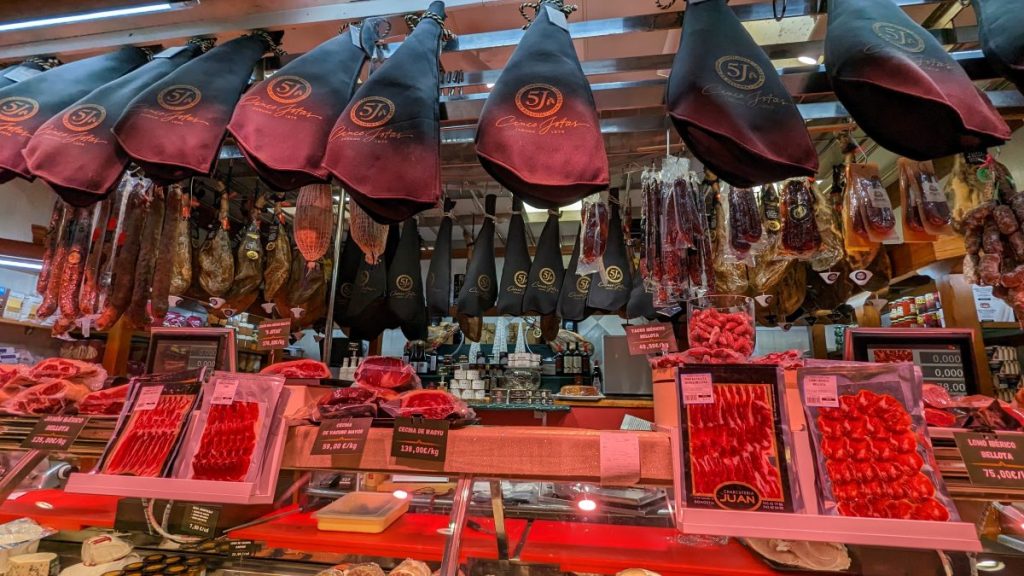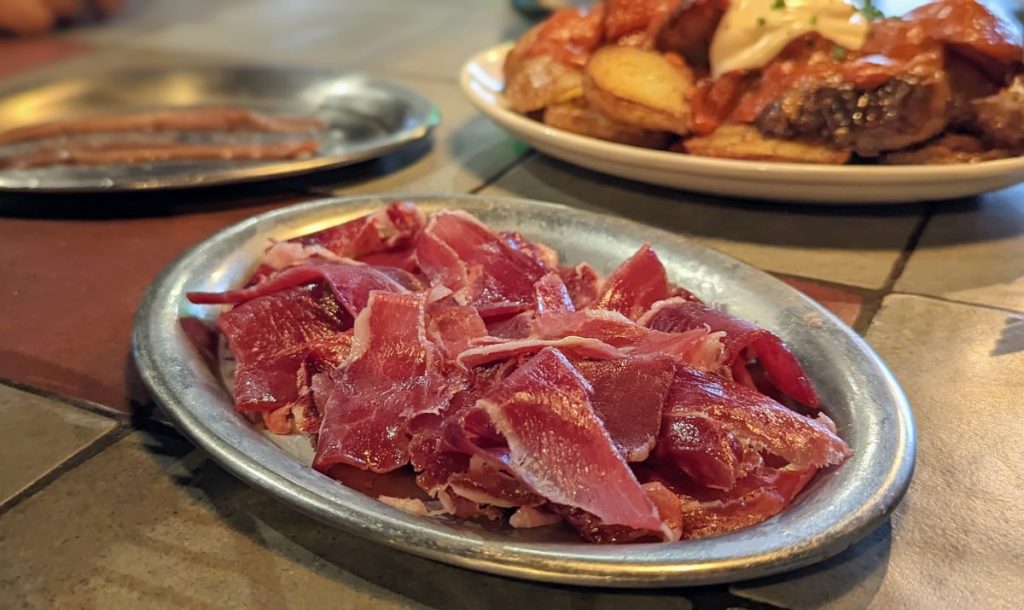Every restaurant in Spain (except for the few vegetarian places) serves ham. Not just any ham, not thick slices of Virginia country ham, nor Italian prosciutto style—no, the ham in Spain has its own very distinct flavor and tradition. Spaniards take great pride in their Jamón Serrano and Jamón Ibérico.

On a recent visit to Madrid, we tasted ham in crusty rolls, ham in tapas snacks, ham with cheese. At the Mercado we were given paper-thin slices right from the line of hanging hams. We decided it’s delicious, it’s addictive, and you don’t need much to get the tangy flavor. I like it better than prosciutto because it has less fat and salt and isn’t as soft. It’s great with a bit of Manchego cheese and Spanish olives, but never, never served with mustard, unless you’re edging into French style ham, with a baguette and a bit of Dijon.

Every region of Spain and every rural household has its ham specialty and preference. The noble pig is taken seriously here, classified by breed, diet, and region. And there’s a chain of restaurants called Museo de Jamón – Ham Museum.
Serrano ham comes from a particular type of white pig bred only in the mountains. For centuries, as far back as the Roman Empire, these pigs have been raised for their delicate flavor. The fresh ham is first rolled in sea salt and then hung to cure in a dry, cool shed for 6 to 18 months. The ham of Trevélez must be cured at least 1200 meters above sea level; it’s considered the sweetest because it takes less salt to mature. Teruel ham is cured for at least a year at 800 meters above sea level.
The ham-master knows the curing is complete by inserting a splinter of cow bone into the meat and taking a sniff, much as a wine-master sniffs the wine. Serrano is sometimes called jamón reserva, jamón curado, or jamón extra, depending upon its origin and preparation method. It’s always dark red, not the nitrites-pink we see in American hams.
There’s another level of Spanish ham that causes diners to wax poetic about “this treasure of Spain,” and “an orchestration of flavors.” It’s Jamón Iberico, ham from the black pig raised in certain areas of Spain. The iberico hog is very fat and its meat can be cured for a longer time, which makes for a more intense, sweet, slightly nutty flavor. Most pigs live on corn and regular feed, but for the ultimate, the supreme ham, you want Jamón Iberico de Bellota—pigs that are fed exclusively on acorns. Under the oak trees, bellota pigs happily and continuously forage for acorns, gaining weight until they are enormous and ready for the “sacrifice.” Traditionally, the whole family would gather for the slaughter and to preserve the meat. The Iberico Bellota ham cures for up to 2 years, drying and dripping fat. Then it’s ready to provide an explosion of flavor that some say tastes of the Spanish countryside itself.
Here’s a surprise: the curing process and the antioxidants in the acorns change the pig’s saturated fats into healthful fats high in oleic acid, the best kind, second only to olive oil. Needless to say, the acorn-fed pigs are expensive. You can find them at good restaurants in Spain and buy them online in the U.S.. Amazon will sell you a 14-18-pound Spanish Iberico ham, aged 18 months, for under $200.
Written by Marilyn McFarlane for EuropeUpClose.com
